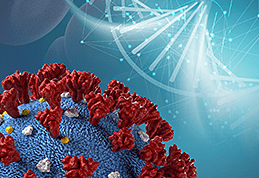
On This Page |
Vaccine-Mediated Immunity | Vaccine Manufacturing | Viral Vaccine Quality Control | Biodistribution Studies | Cell Line Development |
Coronavirus vaccine development is a major challenge demanding reduced time to market. Whether developing a recombinant protein, a DNA/RNA vaccine, or a viral vaccine vector, Bio-Rad has solutions for all phases of the process from early development to preclinical and clinical studies through manufacturing and quality control.
Some products have limited regional availability. Please contact your local sales office for any product availability questions.
These pages list our product offerings for professional use only. Please contact your Bio-Rad local representative to check the availability in your country. contact a Bio-Rad sales specialist to check the availability.
Measure Vaccine-Mediated Immunity for Vaccine Development
A challenging step in vaccine development is characterizing the host immune response and identifying key mediators of efficacy.
These cell phenotypes and antibody profiles are complex, but measuring these responses allow researchers to glean insights into whether immunity is achieved. Moreover, cytokine profiles in disease state and treatment groups can elucidate the immune response associated with vaccine dosing.
Perform Immunophenotyping with Flow Cytometry
Immunophenotyping is used in vaccine development to characterize the immune response of the host and identify key immune players for attenuating viral infectivity or replication. Large-scale assays can benefit from automated high-throughput, high-parameter, multiplex flow cytometry to identify treatments faster.
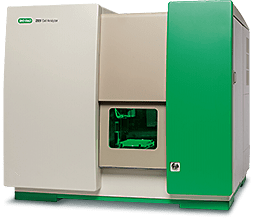
Cell Phenotyping with the ZE5 Cell Analyzer
Profile virus- and vaccine-induced immune responses with the ZE5 Cell Analyzer.
- High-parametric antiviral immunophenotyping
- Rapid discovery of neutralizing antibodies
- Evaluation of T cell-stimulating viral epitopes for vaccine candidates
- Detection of pro-inflammatory cytokines and cytokine receptors
- Seamless integration into automated workcells and LIMS
Immunophenotyping Publications
Immune Surveillance in SARS-CoV-2 Vaccine Development (PDF 112 KB)
Utilizing the multiparameter capability of the ZE5 to Monitor T Cell Exhaustion and Effects of Immunotherapy (PDF 771 KB)
Targets of T cell responses to SARS-CoV-2 coronavirus in humans with COVID-19 disease and unexposed individuals. Grifoni A et al. Cell 2020 May 14
Characteristics of Peripheral Lymphocyte Subset Alteration in COVID-19 Pneumonia Wang F et al. J Infect Dis. 2020;221(11):1762‐1769
SARS-CoV-2, the Virus that Causes COVID-19: Cytometry and the New Challenge for Global Health Cossarizza A et al. Cytometry A. 2020;97(4):340‐343
Reduce Lead Time for Antibody Generation in Vaccine Development
For vaccine development, highly-specific antibodies for both antigen binding and neutralization are required to measure efficacy and dosing. The assays used to measure these antibodies must be robust, scalable, and transferable to laboratories worldwide. They need to be designed and validated rapidly, yet without compromising quality.
We understand that critical antibody reagents for these essential assays must not only be highly specific, but also produced to a consistent quality, and easily available for scale-up according to demand. Bio-Rad’s custom HuCAL antibody generation service can satisfy these needs, providing trustworthy antibodies, and using phage display methods to overcome the challenges of antibody generation by animal immunization.
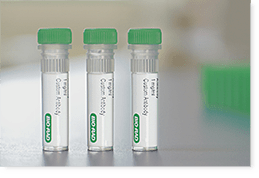
Custom Antibody Generation Using HuCAL
Our recombinant antibodies are selected from the fully synthetic, naïve Human Combinatorial Antibody Libraries (HuCAL) using a proprietary method of phage display. Our latest innovation introduces SpyTag technology to the platform, to build antibodies from modules by protein ligation, and perform site-directed conjugation.
- Rapid custom generation of highly specific Fab antibodies in as little as 8 weeks*
- Isolation of antibodies against antigens, such as SARS-CoV-2 spike proteins or peptides
- Fast, flexible format conversion from Fab to IgG, IgM, and IgA
- Sequence defined antibody with a guaranteed long term secure supply
* A Fast Track service for antibody generation in as little as 4 weeks is available subject to feasibility.
Get a Custom QuotePublication Kar S and Islam R (2020). Rapid and robust bioanalytical assays are critical for SARS-CoV-2 therapeutic and vaccine development and beyond. Bioanalysis, 10.4155/bio-2020-0116
Monitor Inflammation and Immune Response

Browse antibodies to profile immune response to COVID-19 infection and monitor virus-induced inflammation. Choose from thousands of antibodies against targets including:
- Innate immune response to viral infection: pattern recognition receptors
and toll-like receptors - Targeted adaptive immune response against the virus: T cell and B cell markers
- Inflammatory response: cytokines and chemokines
Profile Immune Response Using Multiplex Immunoassays
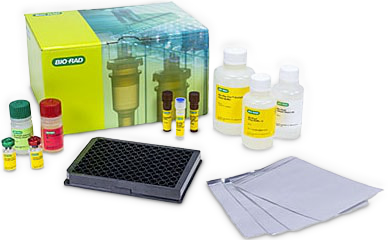
To characterize host response to coronavirus disease, cytokines and chemokines can be quantitated from serum or other samples using Bio-Plex Immunoassay Panels, as recently described in Lancet (Huang C et al. 2020), in a study of clinical features of patients infected with COVID-19.
Bio-Plex Multiplex Immunoassays use Luminex magnetic beads for the quantitation of over 450 biologically relevant targets and get data from just 12.5 µl of sample: markers for inflammation, immune response, and more. Choose assays in premade or custom configurations, or develop your own assays for new targets.
Bio-Plex Immunoassay Development Kits & Reagents for Antibody Profiling
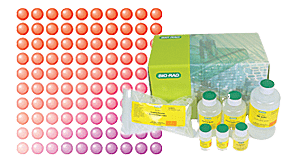
Study immune response across various vaccine dosing and adjuvant additions to measure safety and efficacy by using custom multiplex assays created with Bio-Plex COOH Beads and Coupling Kits and antibodies of your choice.
In addition, the beads can also be coupled with viral proteins and used to discover, detect, and quantitate antibodies that may be useful for therapeutic development.
Learn MoreProtein and Antibody Profiling Publications
Immunological studies of cerebrospinal fluid from patients with CNS symptoms after human papillomavirus vaccination Takahashi Yet al. J Neuroimmunol. 2016;298:71‐78.
Evolution of type-specific immunoassays to evaluate the functional immune response to a vaccine for Human Papillomavirus types 16, 18, 6, and 11 Smith JF et al. Hum Vaccin. 2008;4(2):134‐142.
Evaluation of the long-term anti-human papillomavirus 6 (HPV6), 11, 16, and 18 immune responses generated by the quadrivalent HPV vaccine. Nygard M et al. Clin Vaccine Immunol. 2015;22(8):943‐948
Kinetics and isotype profile of antibody responses in rhesus macaques induced following vaccination with HPV 6, 11, 16 and 18 L1-virus-like particles formulated with or without Merck aluminum adjuvant Ruiz W et al. J Immune Based Ther Vaccines 3, 2 (2005)
Increase Antigen Purification Yields in Vaccine Manufacturing
Identifying the ideal chromatographic method for the antigen in your vaccine is a challenge regardless of the molecule type. Acceptable yield for intact viruses or viral vectors can be difficult to achieve due to their size and inability to enter resin pores. While purity for virus like particles (VLP) or viral surface proteins requires multiple iterations of method development. Our chromatography resins assist in large biomolecule purification while our chromatography platform enables increased automation in method development.
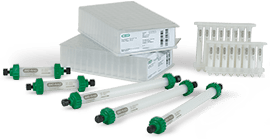
Scalable Chromatography Resins
Bio-Rad manufactures a wide range of chromatography resins that can be used for the purification of your vaccine antigen, molecule or other key components, from lab-scale to process-scale.
- Single-step mammalian virus purification with CHT Mixed-Mode Media
- Purification of virus and virus like particles with Nuvia cPrime Mixed-Mode Resin and Nuvia Q Anion Exchange Resin
- Development of a manufacturing adenovirus process with mixed-mode and ion exchange resins
- Process Resin Solutions for Vaccines and Therapeutics flier
Request Samples Contact a Sales Specialist
Lab-Scale Vaccine Antigen Purification with the NGC Chromatography System
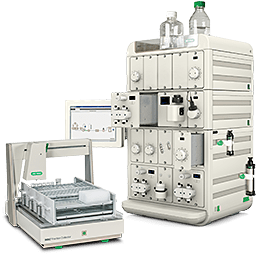
Browse our NGC Chromatography System configuration options for biomolecule purification to support your vaccine development at the research, process-development, and laboratory-scale levels.
Learn More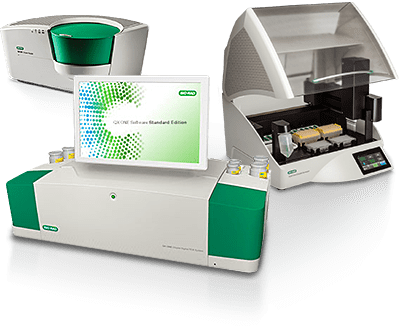
Determine Viral Vaccine Titer
Quantify Viral Vaccine Titer and Determine Potency with ddPCR
For precise measurement of viral genome copies, ddPCR directly quantifies the number of DNA copies with exemplary precision without the need for a standard curve. The absolute nature of this measurement is possible across sample types due to the increased inhibitor tolerance ddPCR provides. In addition, ddPCR also does not require perfect amplification efficiency for quantification so results have a lower coefficient of variation than quantitative PCR (<10% CV) meaning higher consistency across manufacturing stages and eliminating the need for an appropriate, consistent standard. Therefore, absolute measurement of nucleic acids reduces the challenges faced when relying on reaction efficiency and a standard curve.
Choose from the QX200 AutoDG System with auto droplet generation or the new QX ONE Droplet Digital PCR System - a hands-free, fully integrated ddPCR system. Both systems are GMP-ready with installation qualification/operational qualification (IQ/OQ) service and regulatory edition software to assist with 21 CFR Part 11 compliance.
For viral load applications, ddPCR Assays enabled pioneering measurements of HIV reservoirs to near-zero levels, at which conventional qPCR assays were insufficiently sensitive and accurate.
Viral Quantification Publications
Highly Precise Measurement of HIV DNA by Droplet Digital PCR Strain MC et al. PLoS One 2013;8(4):e55943
Viral Quantification: Adeno-Associated Virus Vector Genome Titer Assay (PDF 685 KB)

Droplet Digital PCR Publications
Browse the growing list of cited peer-reviewed journal articles in Droplet Digital PCR research.
Check Vaccine Purity and Composition with Electrophoresis and Western Blotting
Determine the viral protein composition during QC stages of the final vaccine product. The ChemiDoc Imager offers unrivalled imaging with a suite of 21 CFR Part 11 compliant tools to support downstream assays.
ChemiDoc Imaging System
The ChemiDoc MP Imaging System is a versatile instrument for imaging and analyzing gels and western blots. It is designed to address multiplex fluorescent western blotting, chemiluminescence detection, general gel documentation applications, and stain-free technology imaging needs.
Test Impurity Levels for Residual Host Cell DNA (HCD) Host Cell Protein (HCP)
The FDA requires the quantitation and reporting of host cell DNA (HCD) and host cell protein (HCP) in biologics due to their effects on efficacy and toxicity of the final product. HCD and HCP levels are also critically monitored during process development and validation.
Droplet Digital PCR Host Cell DNA (HCD) Assays
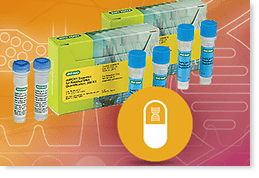
Droplet Digital PCR is ideal for the detection of residual HCD with high specificity and sensitivity. Our ddPCR Residual DNA Quantification Kit is optimized for HCD assays:
- Highly precise, femtogram-level quantification of residual CHO or E. coli DNA
- Direct quantification without DNA purification steps
Publication A Direct Droplet Digital PCR Method for Quantification of Residual DNA in Protein Drugs Produced in Yeast Cells
Hussain M et al. J Pharm Biomed Anal. 2016;123:128‐131
Biologics Analysis Workflow
The Biologics Analysis Workflow is a suite of products designed and validated to assess the purity or identity of biological products in a GMP regulatory environment. The Biologics Analysis Workflow includes:
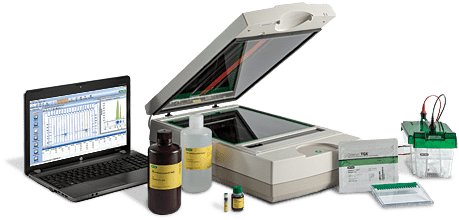
- GS-900 Calibrated Densitometer
- Image Lab Image Acquisition and Analysis Software*
- A electrophoresis starter kit with a Criterion Cell, TGX Gels, buffers, protein standards, and stains — enough for 10 runs
* Optional security module available for 21 CFR Part 11 compliance.
Perform Biodistribution for Coronavirus Vaccine Development
For mRNA vaccines and viral vector vaccines, a thorough biodistribution study is necessary to determine the distribution of the vaccine in both target and off-target tissues. This is required to understand the safety profile of the vaccine.
Quantify Viral Vector and mRNA Vaccines using PCR
Bio-Rad offers high-performance CFX Real-Time PCR Systems and reagents for qPCR, the gold standard for biodistribution studies. For added sensitivity and reproducibility to meet FDA biodistribution assay requirements, Bio-Rad offers Droplet Digital PCR Systems and ddPCR Reagents.
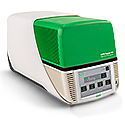
CFX Real-Time qPCR Systems
CFX qPCR Systems deliver sensitive, reliable detection of both singleplex and multiplex real-time PCR reactions.

Real-Time PCR Supermixes and Kits
Our qPCR reagents and kits feature advanced enzyme technology and buffer formulations for reliable amplification, robust reverse transcription, and high-quality real-time PCR data.

QX200 AutoDG Droplet Digital PCR System
The Automated Droplet Generator simplifies the ddPCR workflow, eliminates user-to-user variability, and minimizes hands-on time: walk-away droplet generation in under 5 minutes.

Digital PCR Reagents and Consumables
Our digital PCR supermixes are optimized to deliver maximum PCR efficiency and sensitivity for the amplification and detection of DNA and RNA targets.
Develop Cell Lines for Coronavirus Vaccine Production and Manufacturing
Cell line development is a key workflow in early process development to ensure long-term stable expression of vaccines, including vector design and transfection, clonal screening and selection, and maintaining the clonality of production cell lines. Bio-Rad provides solutions for cell line development, confirmation, and maintenance.
Create Cell Lines using Transfection
Electroporation is a reliable, efficient transfection method adaptable to a wide variety of cell types. Consult our transfection protocol library for optimized protocols for every cell line.
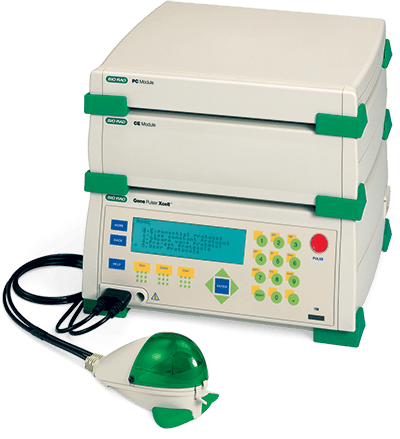
Gene Pulser Electroporation Systems
These electroporation instruments are suitable for all cell types, featuring programs for manual operation, preset protocols, user protocols, and an optimization protocol. Modifiable parameters include time constant, actual voltage applied, pulse interval, pulse time, and waveform selection.
Gene Pulser Electroporation Cuvettes are high-quality electroporation cuvettes that yield reproducible and consistent gene delivery to valuable transfection samples.
Our universal electroporation buffer is formulated for high transfection efficiency.
Browse the Transfection Protocol Library
Screen Cells lines for Clonal Selection, Isolation, and Stability
Flow cytometry and cell sorting can be used to analyze and isolate cells for a particular phenotype. In cell line development, initial screening of transformed cells on a cell analyzer is followed by pool enrichment or single-cell sorting to isolate a stable, high-yielding production cell line. Flow cytometry is also used for monitoring cell line phenotype stability throughout its lifetime, and for assessing thawed cells from frozen master cell banks.
Flow Cytometry Instruments and Antibodies for Cell Line Screening

ZE5 Cell Analyzer
The ZE5 Cell Analyzer is an innovative flow cytometer with flexible configurations to meet a broad range of experimental complexities and throughput needs – accessible for novice flow cytometry users yet flexible enough for flow cytometry professionals.
- Automation/robotics-friendly for high-throughput production
- Integrated 96/384/deep-well plate sample loader
- Multi-parameter analysis — up to five lasers and 30 detectors for 27 colors
Flow Cytometry Antibodies

Bio-Rad Antibodies.com provides a large catalog of highly cited antibodies and the ability to provide custom monoclonal generation in just 8 weeks.
Search for high-quality flow cytometry antibodies using key parameters like target species, host species, isotype, and clone of interest. Additional search criteria include antibody specificity and format.
Find Flow Cytometry Antibodies
Cell Line Screening: Edit Confirmation and Genotyping
After transfection and primary selection, transformed cells are analyzed for correct genome edits by PCR. Additional assays may include determination of transgene copy number variation (CNV) and confirmation of cell line genomic stability.
Droplet Digital PCR Systems & Assays for Cell Line Genomic Analysis

Droplet Digital PCR is the ideal method for genome edit detection, CNV determination, and assessment of cell line genomic stability.
The QX200 AutoDG Droplet Digital PCR System provides sensitive detection of positive clones as well as characterizing the expected frequency of homologous recombination. It allows reproducible determination of gene vector copy number to assess the stability and safety of your cell lines to assure productivity.
Bio-Rad offers a comprehensive portfolio of Digital PCR Assays and Kits for numerous applications including:

ddPCR Assays Brochure (PDF 1.2 MB)
More Coronavirus Vaccine & Therapy Solutions
* Legal Notice:
These products and/or their use are covered by claims of U.S. patents, and/or pending U.S. and non-U.S. patent applications owned by or under license to Bio-Rad Laboratories, Inc. Purchase of a product includes a limited, non-transferable right under such intellectual property for use of the product for internal research and diagnostic purposes only. No rights are granted for use of a product for commercial applications of any kind, including but not limited to manufacturing, quality control, or commercial services, such as contract services or fee for services. Information concerning a license for such uses can be obtained from Bio-Rad Laboratories. It is the responsibility of the purchaser/end user to acquire any additional intellectual property rights that may be required.
Kits and reagents are sold for research use only. Not for use in diagnostic procedures.

